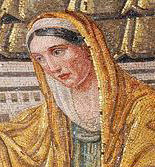Pudentiana

Pudentiana is a Roman virgin and martyr of the 1st century . Her Latin name means Die kleine Sittsame , her feast day in the Catholic Church was May 19th . The more recent research assumes that the holy Pudentiana is more of a legendary figure created by linguistic shifts.
origin of the name
The church of Santa Pudenziana on the Viminal in Rome has been documented since the late 4th century. Brick fragments prove that the ancient building in which the church was established belonged to the possession of the Puden , whose existence is historically certain and who was actually a Christian. The name of the church "Ecclesia Pudentiana", which was used at that time and can be read as an indication of the place or property ("Church of the Pudens"), was reinterpreted in the early Middle Ages as the patronage of St. Pudentiana.
Lore
Almost nothing is known about the life of the Pudentiana . According to her acta , published by the Bollandists (from the 8th century) and the traditional tradition, she also has a virgin, her brothers Timotheus and Novatus and her mother Priscilla the apostle, along with her father, the Roman senator Pudens , and her sister Praxedis Peter granted hospitality in Rome. She also looked after arms with her sister. During the persecution of Christians, they took the remains of 3,000 martyrs from the places of execution, collected their blood with sponges and buried them in their father's house. At the age of 17, Pudentiana suffered martyrdom .
The representation in the apse of the Church of Santa Pudentiana shows the Ecclesia ex gentibus and Ecclesia ex circumcisione (between which Christ stands). These were reinterpreted as Pudentiana and Praxedis in late antiquity . In the apse of the Santa Prassede basilica , which was built after the devotion of the two sisters, both women are depicted between two other saints and flanking Christ.
In 1969 Pudentiana was together with her sister Praxedis by Pope Paul VI. deleted from the general calendar of saints.
Web links
| personal data | |
|---|---|
| SURNAME | Pudentiana |
| BRIEF DESCRIPTION | Christian virgin and martyr |
| DATE OF BIRTH | 1st century |
| DATE OF DEATH | 1st century or 2nd century |